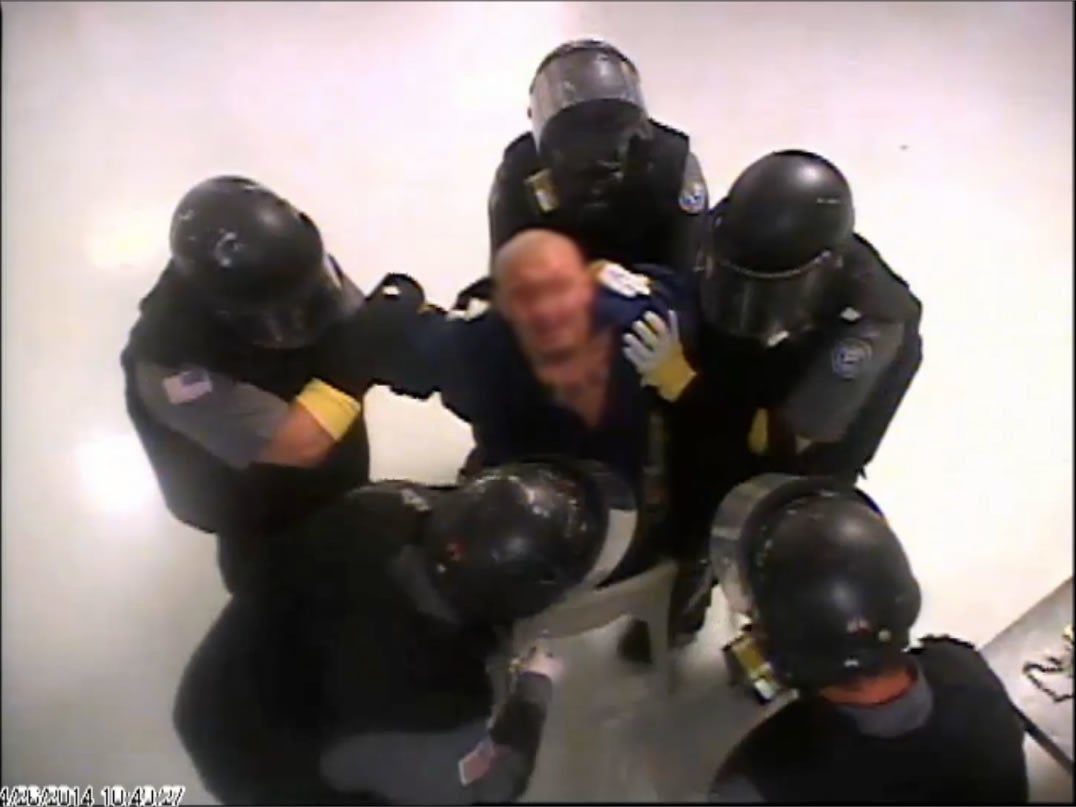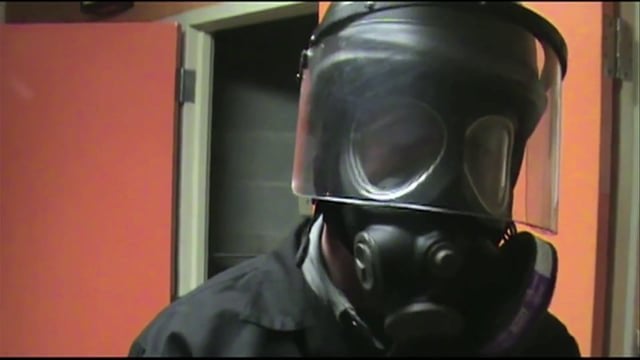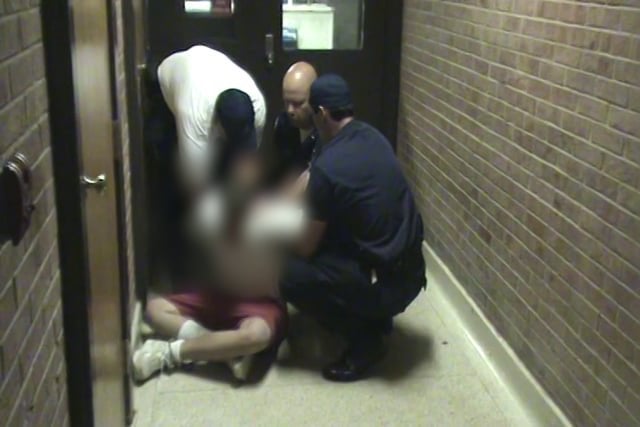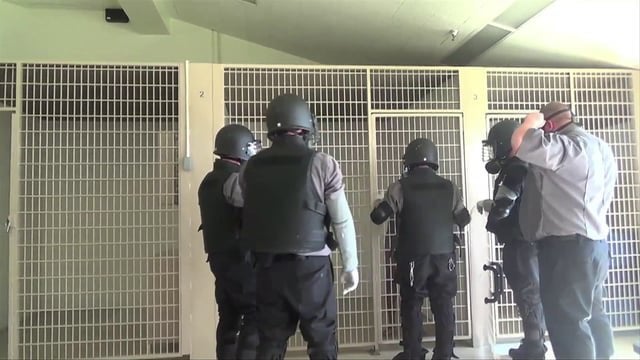When the video above was filmed, the girl on the bed was 17 years old. For the purposes of this story, I’ll call her Jamie. There was a time when she liked acting in goofy comedy skits at her Detroit church or crawling into bed with her grandmother to watch TV. She loved to sing—her favorite artist was Chris Brown—but she was too shy to perform in front of other people.
Jamie, whose mother was addicted to crack cocaine, was adopted when she was 3. At high school, she fell in with a wayward crowd and started drinking and smoking weed. Since she didn't always get along with her adoptive mom, she lived with a close family friend from her church whom she referred to as her sister. One fall day in 2011, they got into a bad fight over their living arrangements. The friend told police that Jamie threw a brick at her, hitting her in the chest, and then banged the brick so hard on the front door that she broke the glass mail chute. Jamie denies the assault—and the police report notes that the brick may not have hit her friend—but she admitted to officers that she was “mad” and “trying to get back in the house.” The Wayne County court gave her two concurrent six-month sentences, for assault and destruction of a building.
In a wealthier Michigan county, kids convicted of minor offenses are almost always sentenced to community service, like helping out at the local science center. Doug Mullkoff, a criminal defense attorney in Ann Arbor, told me that prison in such circumstances is "virtually unheard of." But Jamie is from Detroit, and in January 2012, she was sent to the Women’s Huron Valley Correctional Facility, a prison that holds inmates convicted of crimes like first-degree homicide. From this point onward, her world was largely governed by codes and practices and assumptions designed for adult criminals.
Jamie is 20 now, but her soft brown eyes make her seem younger. When she first came to prison, women old enough to be her mother told her she was cute and promised to take care of her. “They rub on you and stuff, I can’t stand it,” she said. In the seven months before her 18th birthday, prison records show that Jamie was housed with at least three adult cellmates, including one in her 50s who had a history of cocaine possession. Jamie said she was also around adults in the showers and the yard. She had a bunkmate who did drugs she had never been around before, “something you snort.”
In this environment, Jamie found it hard to stay out of trouble. And when trouble came, she didn’t know how to explain herself to the guards. According to Chris Gautz, a spokesman for the Michigan Department of Corrections (MDOC), Jamie “failed in every instance” to meet good-behavior standards that under Michigan law allow certain inmates to have their records scrubbed clean after they serve their sentences. In June 2012, Jamie’s special status was revoked and she was resentenced to up to five years in prison for her original crime. 1
When this news sank in, Jamie snapped. On June 15, 2012, she started yelling so loud and for so long that a correctional officer complained in the logbook that the noise was giving her a headache. Then she climbed on her sink and threatened to kill herself. A group of officers in gas masks hauled her out of her cell as she begged them to put her down. Chemical gas that had been used to subdue another inmate lingered in the hallway, Jamie later recalled, and she started to cough. The officers pressed a spit guard on her face and fastened straps on her arms and legs and chest, a practice known as five-point restraint. Jamie became more and more distressed, but at no point did the officers attempt to calm her or even explain what they were doing. “[There was] snot coming out of my nose. I’m trying to sit up,” she said. “I’m coughing and crying at the same time, and basically the officer said I spit on her and they still tied me down.” She recalled pleading with the guards, “I’m like only 17, you can’t do this to me.”

A page from a guard’s observation log on June 15, obtained through a FOIA request.
After Jamie had been restrained, the logbook shows that she was left tied to a bed for nearly 24 hours. No therapist appears to have visited her during this time. Jamie said that on another occasion, she was restrained for days and urinated on herself. “I’ve had dreams about being held down; nobody can hear me or nothing. It’s terrifying,” she said. The MDOC declined to comment on detailed questions related to her treatment because they concerned “pending litigation” and “personal medical information.”
Jamie had never attempted suicide until she went to prison and her fellow inmates taught her how to cut herself. Over the course of several weeks in June, according to the prison log, she tried to hang herself with socks tied around her neck, to cut herself with wall scrapings and rocks and a comb, to eat paint chips off her door, and to scratch a wound on her arm with empty mayonnaise packets. She told a staff member she wanted her arm to get infected, amputated, and sent to her parents.

A checklist from the June 15, 2012 incident report when Jamie was placed in restraints.The cause of the incident is marked as "none apparent."
The treatment of kids in adult lockups recently received a rare burst of attention with the suicide of Kalief Browder on June 6 of this year. Browder was sent to the jail on Rikers Island at the age of 16 after being accused of stealing a backpack. During the three years he spent there before the charges were thrown out, he was brutally assaulted by both inmates and guards and spent about two years in solitary confinement. His case has drawn attention to what the Justice Department called a “dangerous place for adolescents” with a “pervasive climate of fear.” But the problem runs far deeper than one jail gone rogue.
In the course of reporting on a lawsuit against the Michigan prison system, I obtained a series of videos depicting the treatment of underage inmates in adult facilities, as well as hundreds of prison documents through Freedom of Information Act (FOIA) requests and other sources. (Jamie is a plaintiff in the lawsuit.) These materials show under-18-year-olds being restrained, held in solitary confinement, forcibly extracted from their cells, tasered, and allegedly sexually assaulted. Some of these incidents would not violate any official rulebook, but are simply accepted practices inside adult correctional institutions.
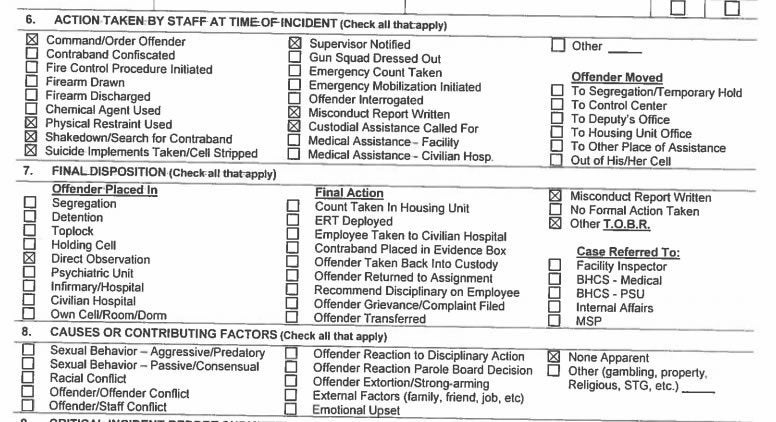
A letter from Jamie to her lawyer.
In 1822, when prison reformers in New York proposed the nation’s first juvenile institution, they saw the need to keep children separate from adults as “too obvious to require any argument.” The juvenile justice system was founded on the idea that young people are capable of change, and so society has a responsibility to help them overcome early mistakes in life. More recent science has only confirmed this principle. Because adolescents’ brains are still developing, their patterns of behavior not yet fixed, they have a far better chance of being rehabilitated than adults. And yet this potential is lost in prisons and jails, which barely recognize any distinction between adults and minors. Amy Fettig, senior counsel for the American Civil Liberties Union’s National Prison Project, said, "The adult system is not designed in any way, shape or form to treat children, to rehabilitate children, or to recognize that children are different than adults."

In the 1980s and ‘90s, the United States was gripped by panic over the specter of the teenage “super-predator,” and the controversial Princeton professor John DiIulio warned darkly of “the youngest, biggest and baddest generation any society has ever known.” These claims would turn out to be wildly overblown, but during this period many states introduced laws making it easier for children to be prosecuted as adults. Between 1985 and 1995, the number of youth incarcerated in prisons and jails roughly doubled. As of 2013, almost 6,000 kids were held in adult facilities across the country. 2
Following Kalief Browder’s death, Kentucky Senator Rand Paul observed that “white kids don’t get the same justice” —and when it comes to sentencing practices, this is empirically true. One national study found that in a single year, almost 10 times more black kids were committed to adult facilities than white kids. Of 257 children prosecuted as adults in Chicago between 2010 and 2012, only one was white.
The decision to charge and sentence a minor as an adult may have very little to do with the severity of the crime. In nine states, 17-year-olds are automatically charged as adults. A nationwide sample of cases sent from juvenile to adult court in 2013 shows that about half were related to property, drug or public order crimes, not serious violent offenses. The decision to direct cases to the adult system is largely left to individual judges or prosecutors, who are often affected by their own “hidden biases” —about skin color, economic class, parental history and other factors—that have little to do with public safety, said Fettig, the National Prison Project counsel.
In the juvenile detention system, staff are more likely to be trained to deal with teens, and more assistance programs may be available. (In Michigan, Gautz said, prison staff receive training on youth issues, but kids in adult facilities receive no special access to counseling and education.) Compared to kids who do their time in juvenile detention, those in the adult system attempt suicide more often. One study, reviewed by the Centers for Disease Control and Prevention, tracked what happened to minors in custody for similar crimes. After they were released, those who had served in the adult system were 77 percent more likely to be arrested for a violent felony than those who were sent to juvenile institutions.
I met one kid, who I'll call Justin, at Thumb Correctional Facility, north of Detroit. He was serving time for an “unarmed robbery” that he committed when he was 15. Justin was hanging out with a friend who had a new Huffy bike and asked his friend to hand the bike over. When his friend refused, they wrestled. According to the police report, Justin grabbed an aerosol can and set the spray on fire with a lighter, singeing the hair on his friend’s arm and yelling, “I’m going to hurt you if you don’t give me the bike!” His friend fled, leaving the bike locked up with Justin.
Justin already had a juvenile rap sheet. For the incident with the bike, which was worth $160, he was sentenced to up to 15 years in prison—about as long as he'd been alive. Justin is small and skinny; he reminded me of a scrawny boy trying to look tough during recess. In juvenile, he said, there were “no correctional officers, no tasing, no seg [isolation].” But he talked about prison like it was open warfare. Some kids would try to get sent to segregation to escape the fighting; others were more scared of the officers, who would "knee you, hit you, say it's acceptable,” he said. He recalled an officer threatening to tase him for throwing a book across the hall, and he has been in segregation three times in the last year, for a total of 32 days. Justin added that he does his best to look out for the younger inmates. “Fourteen-year-olds, they don’t know how to handle it,” he said. When he gets out, he wants to be a deep-sea diver.
The U.S. is nearly alone among developed nations in treating children this way. China, Afghanistan, the Democratic Republic of Congo and Haiti have banned the practice of trying kids as adults. Some Western countries, like the United Kingdom and Germany, do allow youth to be sentenced as adults, but they don’t put them in prison. The Inter-American Commission on Human Rights recently attempted to research the welfare of kids housed in adult lockups. According to a U.S. State Department spokesperson, Colorado and New York allowed the commission’s delegation to visit its facilities. Michigan refused, citing “ongoing litigation.”

Following the deaths of Michael Brown, Eric Garner and Walter Scott, we’ve become very familiar with the excessive use of force by police—the way in which extreme tactics too often become the first response. Something similar occurs behind prison walls, and perhaps the best example is the cell extraction.
Before the 1970s, when corrections officers needed to get an uncooperative inmate out of his cell, they would form a group, preferably of big dudes, who would rush in with a mattress and pin the inmate on the floor. But starting in the 1970s, prisons began training tactical teams—usually three to five officers who may be equipped with tasers or electric shields—to respond to emergencies. Since experts deem sending hundreds of pounds of humanity into a tiny cell to be dangerous to both staff and inmates, officers may first subdue an inmate with chemical spray. Some facilities get creative, with fire hoses or flash-bang grenades. After an inmate is removed from a cell, he or she is usually put in restraints, with a nurse present to check on circulation.
A cell extraction in Michigan of an 18-year-old who committed second-degree homicide at the age of 15. Schwartz, the corrections consultant, described it as a model process: “They do it like this if they knew that the Pope was watching.”
Cell extractions are supposed to be a last resort—say, when an inmate is attempting suicide. In a well-run facility, a staff member will knock on the door and attempt to reason with a prisoner who is not following orders. But Steve J. Martin, a corrections consultant, explained that with militarized teams on call, supervisors became accustomed to using them for minor matters, too. Refusal to return a food tray, for instance, is a surprisingly common reason cited by prisons. In a bad facility, "staff like to do cell extractions because it's an excuse to kick the crap out of inmates,” said Jeffrey Schwartz, a correctional consultant who has advised prisons on disciplinary policies. “There is no question that many cell extractions are unnecessary and avoidable.”
The full video of Jamie’s cell extraction. She was later given a misconduct ticket for accidentally spitting on a guard.
Schwartz called the procedure used against Jamie “wrong and clearly dangerous.” “The female inmate is choking as they first put her down on the bunk, and she is also yelling for them to get off of her,” he said. “The staff should have stopped what they were doing and gotten a medical staff member to the scene immediately.” Pressing the spit guard over her face, he added, increased the chance that Jamie could “have a panic attack” or “vomit and asphyxiate with vomit in her airways.”
There are a handful of states that have developed specific policies for young inmates in adult facilities. Mississippi restricts the use of chemical spray, tasers and cell extractions on youth in prison; New York City announced a plan earlier this year to ban solitary confinement for all inmates under the age of 21. But for the most part, the same policies are applied to all inmates, regardless of age. Schwartz said that staff in adult lockups are simply “more likely to rely on force.”
Officers in Connecticut are allowed to use dogs in cell extractions on a case-by-case basis. Florida, home to the largest under-18 prisoner population in the U.S., favors CS gas, although a spokesman said it does not use tasers. Last year, the Justice Department noted that teenagers at Rikers were subject to cell extractions that “too frequently lead to physical altercations and unnecessary injuries.” From an inmate at Michigan, I heard a recent report of officers rushing into a young prisoner's cell and stripping him of his clothes, as well as other uses of force. But when I reached out to the inmates involved, they didn't respond. Their lawyers said that the prison email system is closely monitored by MDOC, and the inmates were worried they would receive misconduct tickets for reporting improper conduct by staff.
In response to a FOIA request for all “critical incident” reports that detail staff using force on youth in a recent 14-month period, Michigan produced only one—of an inmate attacking a staff member. However, there are multiple scenarios in which officers aren't required to file a report, including “routine force” used to separate fighting inmates and “routine application of restraints," which generally refers to handcuffs. Officers also don't always have to report the deployment of tasers, which were used against minors at least nine times in that period. Gautz told me that he had asked staff at Thumb whether there had been any cell extractions of minors in the past 14 months, but “they could not recall any occurring." He confirmed that the same forcible procedures are used on all prisoners. In a fight, he said, officers "are not going to ask them for their date of birth."
This 2009 video is of a 16-year-old inmate with learning disabilities at Thumb Correctional who threatened to hang himself. Guards press him down on his bed; after a while, he softly begins to sing.
There is an increasing body of scientific research showing that when adolescents suffer from extreme stress and trauma, it can inflict permanent damage on their bodies and brains. A study led by the CDC found that children who experienced multiple forms of trauma, such as physical and sexual abuse, had a life expectancy 20 years shorter than their counterparts.
There is also significant evidence showing that the parts of the brain that govern decision making and understanding consequences don’t finish developing until as late as 25. 3 When an adult is put in restraints, he is more able to make the calculation that if he keeps his cool, the ordeal will end sooner. Young offenders are “much more reactive,” said Bob Houston, the former director of the Nebraska corrections system. “They don’t think things through like adults.”
Juvenile justice experts say that a better way to handle misbehaving young inmates is through a positive incentive program, where kids lose points if they act out. A facility also needs staff trained to calm down kids, including on-call mental health workers. But since adult facilities tend to be punitive cultures, the default response to any issue is often punitive. Minors can be punished simply for exhibiting typical teenage behavior, like disobedience, not fully understanding prison rules, or not knowing how to cope with anxiety.
Paul DeMuro, a senior consultant to the Annie E. Casey Foundation, which advocates for juvenile justice reform, reviewed this video. He noted that the officer clearly "doesn’t know how to talk to kids."
I thought of this when watching a video taken in 2010 at the Special Alternative Incarceration Facility in Michigan, an institution for male trainees. In the middle of the night, a corrections officer wakes up a 17-year-old boy and accuses him of writing a threatening letter to his roommate. The boy, upset and confused, protests that he hasn’t done anything wrong. "If you don't stop, we're going to use force on you,” the guard says. “And I'll tell you what, it won't be freaking pretty. Now you're going to stand there, like a grown man, and do as you're told to, like a grown man, and stop throwing a 2-year-old temper tantrum."
The boy faces the wall as instructed, but the guard keeps needling him: "Now I've got to stand here and baby-sit you. You like that?” Finally, the boy asks again why he’s there. “Shut up. Shut up,” the guard says.
Fearing that he might go to jail for something he said he didn’t do, the boy can’t control himself any longer. He starts yelling that he wants to kill his roommate. A staff member hits him with “common perennial knee strikes” that appear to land at his crotch. He cries hoarsely as officers put him in restraints. "It don't matter. My life over … I’m 17 years old and I’m about to have to go to prison. I wanted to try and get my GED so I can get on with my life. Because a person like me, I'm probably nothing but a statistic.”

In March, I drove to Ionia, Michigan, a quiet town that is home to a cluster of maximum-security prisons. One of them, Michigan Reformatory, was built in 1877. Its inmates used to grow their own vegetables and herd dairy cows for sustenance, although by the time of my visit, the farm was long gone.
I went there to talk to one of the plaintiffs from the Michigan lawsuit, whom I am calling Max. He is 20 now, but he has been in an adult prison since he was convicted on two counts of armed robbery at age 16. Max fired a blank at a store employee; he and a friend stole some cash and two bottles of fruit-flavored wine. Tall, with tattoos peeking out from his blue and orange uniform, Max hasn't lost his teenage slouch. At first he responded to my questions with brief answers, but as he opened up about prison life, his eyes widened and his words flowed fast, as if he couldn't believe what had happened to him over the past four years.
In the spring of 2012, about a year after he entered the system, Max said that his bunkmate at Thumb Correctional Facility, who was then 19, raped him. Max told me he was asleep on the bottom bunk and woke up with his wrists and ankles tied, his bunkmate on top of him. Afterward, he said, his bunkmate threatened to hurt him if he told anyone. “I was crying, scared,” Max told me haltingly. “I don’t know how to describe it.”
Around that time, Max visited the prison health clinic; the medical report says that he had "rectal bleeding" and was "using up laundry, especially underwear.” Max said he was questioned by multiple people, some of them correctional officers. He wanted to tell them about the assault, but didn't trust them not to tell other inmates or "turn it into a joke." MDOC confirmed that Max and the alleged inmate shared a cell, but declined to discuss the particulars of the incident. When I reached out to the inmate, he wrote, “I don't know nothing about what’s going on with [Max],” and added, “I respectfully ask that you keep me out of your reporting.”
In the fall of 2012, Max said he was sexually assaulted again, this time by a 32-year-old bunkmate at Oaks Correctional Facility. He said his bunkmate forced him to his knees and then showed Max his erection. Max hit the emergency light in his cell. A correctional officer reported that he found Max "kneeling" with "clenched fists and his forearms covering his face.” and that he didn't see Max throw any punches. Max told officers that he had been assaulted, but he didn’t want to say that the attack was sexual, and he was written up for fighting. Attempts to obtain comment from Max’s alleged abuser were unsuccessful; Gautz declined to comment on the details of these allegations, but noted that generally, when an inmate reports being sexually assaulted, the incident would be investigated by internal affairs.
The federal Prison Rape Elimination Act, which was passed in 2003 and whose rules were issued in 2012, is supposed to protect minors from such situations. PREA stipulates that youth may not be held within "sight and sound" of adult inmates. In 2015, only 10 states reported that they were in full compliance; Michigan was not one of them.
In December 2013, attorneys for a number of inmates filed a lawsuit in the trial court for Washtenaw County accusing Michigan of violating the constitutional rights of children held in adult prisons. Alleged PREA violations are at the heart of the suit, which contends that the state housed under-18-year-olds with adult inmates, exposing them to sexual violence, subjecting them to solitary confinement and force, and depriving them of an education. The case will go to trial after February 2017. Gautz said, “We are confident that when all of the facts are presented in court—rather than a few allegations strategically presented to the media—the outcome of this case will be in the favor of the State.”
Michigan doesn’t deny that it used to house 17-year-olds and even some younger inmates with adults. Max, who is one of the plaintiffs and whose allegations of assault are detailed in the complaint, had over a dozen adult cellmates before he turned 18, according to prison documents. But the state maintains that it started separating all youth from adults in 2013 when PREA implementation began and has argued that the allegations are no longer relevant. According to Gautz, both male and female youth now have their own housing units and yard areas. On the "rare occasion" when a kid has to be in an area where there may be adults, like the chow hall, they "are not left alone," he said. (The plaintiffs dispute that this is always the case.)
It’s difficult to judge how adequate Michigan’s measures have been, since MDOC does not distinguish between minors and adults when collecting statistics on sexual abuse. When I asked the agency how many incidents of inmate sexual harassment and assault were committed against kids over a recent 14-month period, the public records office asked me for $41,984 to compile the data. Still, as the Justice Department pointed out in a brief last year about the lawsuit, simply holding underage inmates separately doesn’t guarantee they are in an environment free of sexual misconduct.
In November 2013, months after PREA implementation began, Michigan interviewed teenage inmates held at Thumb Correctional to see if they felt safe. In affidavits collected by Michigan as part of the lawsuit, most said they did. However, one said that in September, a guard had told him he would “rape my fat ass if I wasn’t 17.” Another 17-year-old inmate said, “[A]bout three weeks ago, an officer … told me that he was going to make sure I go up North to be fucked in the ass.” 4
Some kids later signed affidavits saying that they had been pressured by Michigan to participate in the interviews and even threatened with isolation. (An attorney for Michigan called the claims of intimidation "absolutely false.") One wrote to his lawyer, “I sign a paper without reading it and was mad because I didn’t realize he was using [his] power to trick me.” Terry Kupers, a psychiatrist who reviewed the interviews for the plaintiffs, said that the state violated “every single point in the protocol” for interviewing sexual assault survivors and was “very unlikely to uncover the truth.”

An affidavit submitted by Michigan in court proceedings and obtained via FOIA.
Michigan corrections staff are trained to handle sexual assault and harassment allegations, Gautz said. However, the training doesn't specifically address issues specific to younger inmates. In January 2014, Thumb’s PREA coordinator made a prison rape joke about Justin Bieber on his Facebook page. Nine months later, still employed by Thumb in a different position, he was sued by a female colleague for sending her a “sexually explicit image of his genitals” and leaving “a voicemail on her phone expressing to her that he was masturbating.” (In a filing, the man said he "neither admits or denies" those particular allegations.) MDOC confirmed that the man, who did not respond to requests for comment, still works there. Gautz said, "The private social media postings that this or any of our other 14,000 employees make during off hours do not reflect ... the great strides we have taken to comply with the federal Prison Rape Elimination Act.”

An affidavit from an inmate who has been incarcerated at MDOC since age 15 and is involved in litigation against the state.
Separating young inmates from adults also does not address other problematic aspects of their treatment in adult facilities. One is the frequent use of solitary confinement. The United Nations Special Rapporteur on Torture has condemned the practice of placing minors in extended isolation in unequivocal terms, and at least 19 states now say that post-trial juvenile facilities cannot isolate kids for longer than one week. But in Michigan, 28 kids in adult facilities spent an average of 52 days each in punitive segregation between 2011 and 2013. Seventy-nine kids spent an average of 24 days each in some other form of isolation such as protective custody, according to prison documents. In April, I spoke to a man whose 16-year-old son has spent more than two months in segregation at Thumb since March.
The inmates I met who had entered prison as teenagers had different ways of coping with the stress. Max told me that he found comfort in the dogs in his housing unit, who were cared for by other inmates. I was about to ask him more when a tall, clean-cut man in business clothes entered the visiting room and told me to come with him into the hallway, away from Max’s attorney.
The man identified himself as David Dwyre, a special agent with the criminal division for the state Attorney's General office. He issued me a subpoena for my hand-written notes from my interview with Max and an interview I had planned later that day. Dwyre asked me to sign a paper confirming I had received the subpoena. I signed, feeling shaken, and when I returned to the visiting room, Max didn’t want to talk about the dogs any more.
“I don’t want them to know what I look forward to,” he said. 5

Corrections officers risk their lives when they come to work. In Michigan in recent years, inmates have bashed an officer in the head with a padlock wrapped in a sock, attacked a nurse with a thermometer, and stabbed a guard with a makeshift ice pick. The environment fosters a military-style loyalty among officers, a sense that nobody truly understands what they do for a living. Dennis Schrantz, who oversaw MDOC’s prisoner re-entry program before retiring in 2009, told me, “Every prison is its own kingdom, its own city.”
This makes it challenging to find officers—working or retired—who are willing to talk about their job. Neither MDOC nor the Michigan Corrections Organization, which represents nearly 7,000 corrections personnel in the state, would make anyone available for an interview. But after dozens of inquiries, I found a 54-year-old former correctional officer named Thomas Burke, who worked for MDOC for 25 years and retired in 2010, who was willing to talk.
Burke spent his entire career at Charles Egeler Reception & Guidance Center, an intake facility for new male inmates. At the time, its policy was to house 17-year-olds with adults, while those under 17 were isolated from the rest of the population, Burke said. The under-17s lived in separate blocks, took showers at different times and had to be escorted by a guard whenever they went elsewhere in the prison. To Burke, this arrangement was completely inadequate. “Everything about their setup was very embarrassing,” he told me. In the prison yard, he said, older inmates would taunt the kids, who were fenced off in an area known as the sandbox: “‘Want me to change your diaper?’ ‘Want me to read you a bedtime story?’ [It was] very dehumanizing.”
In 2004, Burke started a mentoring program to help young inmates, focusing on those who had family members in prison. It wasn’t long before a group of correctional officers started asking why he wanted to “babysit somebody else’s kid,” he recalled. “I would get letters sent to me through the institutional mailing system, threatening to harm me in some kind of way.” Burke was an experienced officer and he had the support of his superiors, but some officers made their disapproval known by doing “extreme cell shakedowns” when they were assigned to his block. Once, Burke said, he left an interim partner there during a break and returned to bedlam: The substitute had trashed the inmates' cells and tossed their belongings onto the floor. The harassment got so bad that he closed the program after a year.
Changing the treatment of children in prison means more than changing the location of their housing or the schedule for their showers—it also means changing the culture. And when adult facilities have attempted to overhaul policies for young inmates, they have found it to be a daunting task. New York City officials recently issued new policies for the treatment of underage prisoners on Rikers Island. Seventy-five officers resisted the reforms and were transferred to other jobs, according to The New York Times. Frustrated with the slow pace of change, the U.S. Attorney’s Office for the Southern District of New York will install a federal monitor to restructure the facility.
In Texas, sheriffs who run the jail system are running into numerous problems trying to separate 17-year-olds from adults. Not only do they need to house teens in separate quarters, but they also have to keep them apart in classes, church services, and visitation and medical areas. Sheriff Lupe Valdez of Dallas County said that her county is spending at least $40,000 a week in order to meet these requirements. Along with her counterparts in Brazos and Harris counties, she supports raising the age of juvenile criminal jurisdiction in Texas so that all 17-year-olds automatically go to the juvenile system.
On the national level, the issue rarely surfaces, even in a newly receptive political climate for criminal justice reform. Legislation backed by Republican Senator Rand Paul and Democratic Senator Cory Booker would ban punitive solitary confinement in juvenile facilities, but wouldn’t affect youth held in adult prisons. When I asked Burke whether he thought there was some way to detain minors safely in the adult system, he was unequivocal. “I totally disagree with having any inmate under the age of 18 in prison,” he told me. “I totally disagree with that.”

On May 1, I went to see Max again. He had been removed from the housing unit with the dogs and sent to solitary for punching an inmate, an assault he said he didn’t commit. (His accuser told me in a letter, “He hit me soo hard,” although another inmate on the scene testified that he hadn’t seen Max fight with anyone.) His lawyers said they believe evidence will show that Max has been retaliated against for his participation in the lawsuit and willingness to speak to the press, and plan to address the matter in court. When Max found out he was going back to segregation, he lost it. He lashed out against staff members, earning more misconduct tickets. 6
On April 14, as the video below shows, he was forcibly put on suicide watch for “making threats of self harm.” He refused to submit to a strip search—he told me that taking his clothes off in front of the guards gives him flashbacks to his sexual assaults—and was gassed with chemical spray. When I saw the video, I could hardly believe it was the same person. In our conversations, he was calm and straightforward, chatting about playing basketball and football growing up. In the video he is naked, yelling and crying, the burly officers eyeing him like a wild animal.
We spoke in a tiny room through a chain-link divider. Max had lost a noticeable amount of weight and his cheekbones protruded sharply from his face. He told me he was reading The Hunger Games to try to take his mind off things. There were days when he didn’t want to talk about what had happened to him, but he worried that if he stopped, the prison would win. “I have been forced on suicide watch, gassed, I’m in isolation," he said. “What more can they do to me?”
Ten days later, Max was sent to the hospital after overdosing on pills. Not long after that, he tried to hang himself. The MDOC said that he had made the noose by tearing a pillowcase into strips and issued him with a misconduct report for destroying state property.
